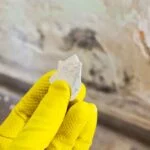Condensation is not uncommon.
In fact, most people have experienced some form of in their home at one point of another, especially during winter.
Did you know that 1 in 5 UK homes suffer from condensation problems?
Perhaps not, but you do now. However, when you discover how condensation occurs, it makes sense.
What is condensation?
Condensation appears when warm air collides with cold surfaces or in fact, when there’s too much humidity in your home. When warm air that’s packed with moisture comes into contact with a cold surface, it cools down at a quicker rate and releases the water, which turns into the liquid droplets we then refer to as condensation.
Where does condensation form?
Although we’ve discussed condensation forming on chilly surfaces, it can actually form on any surface. It’s more commonly seen on surfaces that are non-absorbent; surfaces in your home such as bathroom tiles, bathroom suites and windows. Don’t forget that just because you can’t see it, it doesn’t mean it isn’t there! Condensation can be quickly absorbed by household furnishings and upholstery, so condensation on windows can also means condensation on your bedspread, carpets and curtains! If you’re concerned that condensation may be an issue, it’s best to seek the help of a professional to put your mind at rest and restore your property.
What actually causes condensation?
Believe it or not, it’s nothing out of the ordinary that causes condensation in your home. Actually, it’s quite the opposite. Everyday activities such as drying clothes, washing up, cooking and showering can all causes condensation that could damage your home. Without adequate ventilation, you’d soon notice issues in your home which could even lead to worse problems, such as damp. You can actually prevent condensation in your home yourself by following this easy guide.
Why is condensation worse when it’s cold?
It’s no secret that during winter months, people spend more time indoors that they do outside. Keeping your home warm during December months can in itself cause issues when adequate ventilation isn’t available, not to mention others household activities such as using a tumble dryer, can contribute to the cause of condensation. Naturally, with all this going on in the home, moisture and humidity levels increase, and we’re not opening our windows to allow for natural ventilation. Be aware!
What kind of health risks does condensation pose?
The health risks posed by condensation aren’t dissimilar to those that can be caused by damp, and babies and elderly people should be considered with due caution due to their weaker immune systems. Condensation can contribute to, and cause problems, to people with allergies or respiratory issues such as asthma or bronchitis, so it’s vital to not allow any condensation or damp issues to be left alone or forgotten about.
What damage can condensation do to my property?
Condensation can cause a number of issues to your home if left untreated, even over a short period of time you may start to notice changes to your home. Of course, there are strong indicators of damp and condensation which include but are not limited to: black mould, peeling wallpaper and damp patches. Other tell-tale signs of condensation in your home can include: black mould around window seals, water droplets on window and kitchen counters, etc.
How can I prevent condensation in my home?
There are obviously many ways to prevent condensation in your home but the most important is to make sure that your property has adequate ventilation, and that any opportunities to ventilate to your home are taken e.g. after you’ve had a shower or bath, open the window to allow the additional moisture and humidity in the air to escape. If you believe your home might have an issue with damp or condensation, we would always recommend having your home assessed by a professional to pinpoint the causes of condensation and more importantly, the preventative measures to take.
Thinking about condensation control for your home? Get Keith Rennie to assess your property, he will thoroughly survey the condensation issue and make a full assessment on works required to repair any damage. Contact Keith Rennie today!








